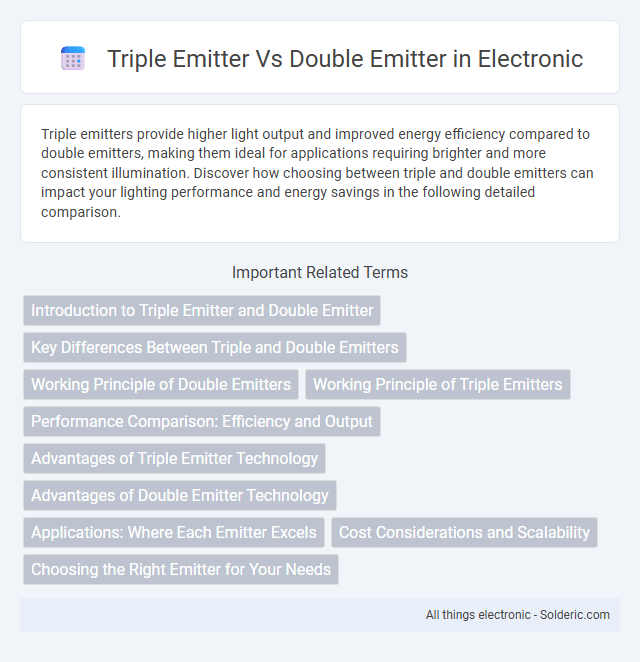Triple emitters provide higher light output and improved energy efficiency compared to double emitters, making them ideal for applications requiring brighter and more consistent illumination. Discover how choosing between triple and double emitters can impact your lighting performance and energy savings in the following detailed comparison.
Comparison Table
| Feature | Triple Emitter | Double Emitter |
|---|---|---|
| Number of Emitters | 3 | 2 |
| Light Coverage | Wider coverage | Narrower coverage |
| Power Consumption | Higher | Lower |
| Brightness | Brighter output | Moderate output |
| Application | Complex lighting setups, broad illumination | Basic lighting, focused illumination |
| Cost | Higher | Lower |
| Heat Generation | More heat | Less heat |
Introduction to Triple Emitter and Double Emitter
Triple emitter and double emitter refer to types of transistor configurations commonly used in electronic circuits to control current flow. A double emitter transistor has two emitter terminals enabling it to handle input signals from multiple sources or perform logic functions, while a triple emitter transistor includes three emitters for more complex signal processing and higher integration in digital circuits. These configurations improve switching speed and circuit efficiency by allowing multiple inputs to influence a single transistor's output in logic and amplification applications.
Key Differences Between Triple and Double Emitters
Triple emitters feature three distinct emitting elements, enabling higher power output and improved signal clarity compared to double emitters, which have only two. The enhanced number of emitters in triple designs allows for better spatial resolution and broader frequency range coverage. Double emitters often offer simpler integration and lower cost but lack the advanced performance characteristics found in triple emitter configurations.
Working Principle of Double Emitters
Double emitter devices operate by utilizing two separate emitter regions to enhance charge carrier injection efficiency, boosting overall device performance. Unlike triple emitters, double emitters simplify the current distribution, improving stability and reducing complexity in semiconductor devices. Your application benefits from improved reliability and controlled electrical characteristics inherent to the double emitter working principle.
Working Principle of Triple Emitters
Triple emitters use three active regions to emit light simultaneously, enhancing brightness and efficiency compared to double emitters with two active regions. The working principle involves current injection through the emitter layers, allowing electrons to recombine with holes across multiple junctions for increased photon generation. Your device benefits from higher output power and improved thermal management due to the distribution of current in the triple emitter structure.
Performance Comparison: Efficiency and Output
Triple emitter LEDs exhibit higher efficiency and greater light output compared to double emitter models, delivering more lumens per watt and improved energy savings. The triple emitter design distributes heat more effectively, enhancing performance stability and extending lifespan under continuous use. Your choice of a triple emitter can result in brighter illumination and lower power consumption, making it ideal for applications requiring high output and efficiency.
Advantages of Triple Emitter Technology
Triple emitter technology offers higher light output and improved color rendering compared to double emitter systems, enhancing visual clarity and vibrancy. Its increased efficiency reduces overall power consumption and heat generation, extending device lifespan and lowering maintenance costs. You benefit from more precise illumination and greater energy savings in applications ranging from automotive lighting to advanced displays.
Advantages of Double Emitter Technology
Double emitter technology offers enhanced thermal stability and lower power consumption compared to triple emitter configurations. It provides improved signal integrity by reducing noise and crosstalk, resulting in more reliable and efficient device performance. The simpler architecture of double emitters also enables cost-effective manufacturing and easier integration into various electronic applications.
Applications: Where Each Emitter Excels
Triple emitters excel in high-performance lighting applications such as automotive headlights and industrial machinery due to their enhanced brightness and energy efficiency. Double emitters are preferred in general lighting and budget-sensitive projects where moderate illumination and cost-effectiveness are prioritized. Each emitter type optimizes light output based on specific use-case requirements, ensuring optimal performance across diverse settings.
Cost Considerations and Scalability
Triple emitter technology generally incurs higher initial costs due to more complex design and manufacturing processes compared to double emitter systems. However, triple emitters offer enhanced performance and efficiency, which can lead to lower operational costs and better scalability in large-scale applications. Economies of scale and advancements in production techniques are gradually reducing the cost gap, making triple emitter solutions increasingly viable for mass deployment.
Choosing the Right Emitter for Your Needs
Choosing the right emitter depends on your irrigation system's efficiency and plant water requirements. Triple emitters deliver water at three points, providing broader coverage and reducing water stress for larger plants or uneven soil. Double emitters offer moderate water output suitable for smaller plants or tighter spacing, optimizing water use and minimizing evaporation losses.
Triple emitter vs Double emitter Infographic

 solderic.com
solderic.com